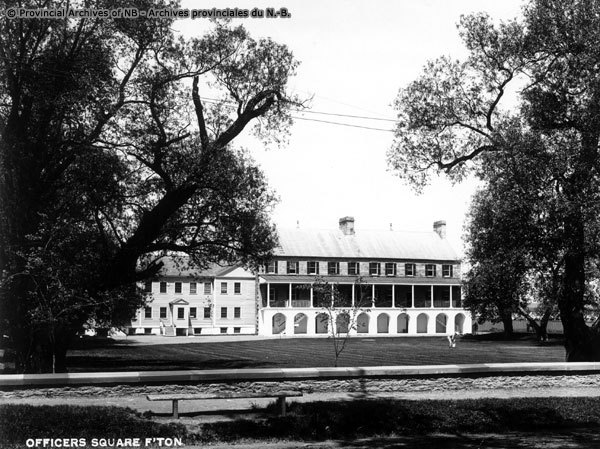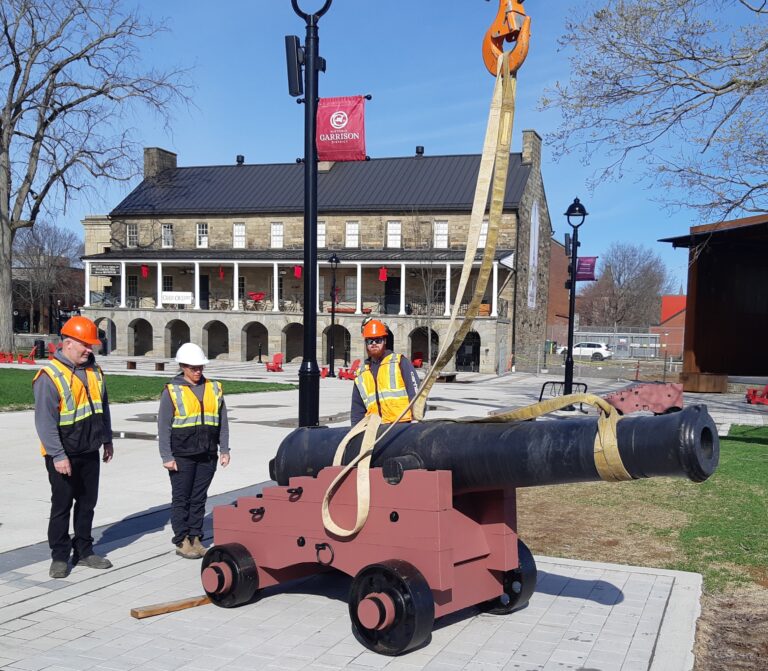Joel Rumson
Officer Square, situated in Fredericton, New Brunswick’s Historic Garrison District, has been held as a historic and eventful center piece by many Fredericton residents. Initially established by the British Government, the many buildings scattered around the square provided support to the military through housing, stores, and security. Out of these numerous original buildings, only four stand today; the Soldiers’ Barracks, the Guardhouse, the Officers’ Quarters, and the Militia Stores Building.
Originally built of wood in 1786, the barracks had later gone up in smoke, where the majority of the barracks were destroyed. Which in 1810, caused for the reconstruction and replanning of the land. In 1816, a new building had been constructed, this time, learning from their mistakes, architects put stone firewalls throughout the buildings in aim to reduce losses in the case of a fire. The fire walls proved effective as in 1837, when a fire had broken out, only the river-side of the building was damaged.
Between 1839-1841 the damaged mess kitchen and hall were reconstructed using stone from the Rainsford Quarry.
A decade later, in 1853, the previous wooden sections of the buildings were demolished due to deterioration and rebuilt with stone.
British army officers occupied these stone and wooden structures until 1869. Then, for the next 30 years, the Royal Canadian Regiment’s officers, Canada’s inaugural permanent military unit, managed the grounds.
Following its seven-year tenure as an army training base during and after World War I, the New Brunswick Liquor Commission and other governmental bodies then took over the stone buildings until finally the York Sunbury Museum, now known as the Fredericton Region Museum, moved in during the early 1960s.
Historically, Mi’kmaq and Maliseet peoples enjoyed Officer Square as well. The area of the present-day City of Fredericton was first used for seasonal farming by the Mi’kmaq and Maliseet peoples, with corn as the primary crop grown in the area.
Singing many traditional songs and chants during spiritual rituals, feasts, mawiomi (gatherings), cultural ceremonies and powwows, the Mi’kmaq and Maliseet experienced a range of musical displays to which remains and artifacts are still found to this day.
Considering the previous presence of military, acadians, as well as Indigenous communities, it is certain in saying a magnitude of past cultural events have taken place within the Square’s borders that hold extreme value.
But, it is also clear to see that alongside the rich and deep history, a new form of history has been slowly growing over the past 30 years, which is, the Fredericton music scene.
From Indigenous communities of the 1600s to the French in 1700s, then British in 1780s and finally the Canadian military in the 1800s, Officer Square was where communities grew, and fell. Military troops patrolled, trained, and called home to Officer Square. Now, events taking place are… slightly different.
Specifically, and justifiably the most popular event within the square being the annual Harvest Jazz n’ Blues Festival (Harvest festival). Harvest is the largest music event in the city of Fredericton. Originally spread over four days, with 9500 participants, 25 musical acts, and 17 venues around downtown Fredericton, the city came alive.
The Calithumpians utilized the Officer Square area and have also been entertaining Fredericton audiences in the downtown area for over 30 years. Based in the outdoor theater of Officer Square, the troupe’s offerings include free outdoor summer theater in Officers’ Square, military reenactments and heritage interpretation at Barracks Square among many other displays of both music and theatrics.
Canada Day festivities have also been held within Officer Square. Beginning with family oriented activities such as face painting, food trucks, carnival games, free bouncy castles, Canada Day Trivia, and a magic show. The event followed later that day with a diverse lineup of musical artists, including local talent like Riley Taylor, a Canadian Country Music Singer. Taylor headlined just before the city put on the largest display of fireworks ever held in Fredericton, which had begun from the Westmorland Street Bridge. Alongside Taylor, many DJs and other forms of music are performed. Moreover, the Canada Day event highlights the importance of reconciliation with Indigenous Peoples and acknowledges the rich cultural offerings, shopping, and dining options in Downtown Fredericton.
But, although the square was flourishing, the city wanted to do more.
It wasn’t until 2016 when the city of Fredericton purchased the land of Officer Square from the provincial government for a dollar that things really began to pick up. Council had already begun planning, and two years later, an archeological assessment was done at the square.
Although Officer Square has been known commonly as the heart of downtown music and events. With the area under new ownership, the city wanted to ensure cooperation with rights holders and demographics.
“The City is ready to move forward in a way that both creates the community gathering space residents have asked for and offers the opportunity to collaborate with Indigenous partners to identify, protect and accurately portray past Indigenous use of the property,” said Fredericton Mayor Kate Rogers.
The assessment, in 2018, through indigenous consultation alongside archeological work, did yield something of interest, a Paleo shoreline – an ancient shoreline of the past– at the southwest corner of the Square. Furthermore, Indigenous and Acadian archeological resources had been uncovered and by collaboration with respective communities the city avoided any future revitalization in the area.
By saving eight mature trees, avoiding chemical use in the rink, keeping existing buildings, doing archeological research, receiving heritage permits, adding greenspace, and increasing the longevity of officer square, the city tried to prove their efforts in listening to the views of people. Perhaps even trying to prove to the people why it is valuable.
Many citizens of Fredericton were thrilled with the decision to move forward with the revitalization of Officer Square, after all, many people use the Square in one way or another. But, alongside excitement came grave sadness through heritage lovers and Indigenous communities.
The revised Officers’ Square Revitalization Project, presented at a Special Council Meeting on November 5, 2018, unveiled a conceptual plan that, at this time, addressed public feedback and most importantly significant natural, cultural, and heritage elements within the square.
The 2018 plan preserved eight large mature trees, plus an additional four trees. As well, the plan introduced a new tree planting initiative that doubled the number of trees on the site. The redesign increased green space slightly from the original plan and ensured the re-establishment of an ornamental cast iron fence – which was seen as a largely important aspect by the citizens of Fredericton.
Several key principles guided the revision of the plan, including the conservation of mature trees, respect for heritage, balance of current uses (public space, heritage interpretation, events), and public safety considerations. The plan – flexibly – adhered to heritage conservation standards by consulting with experts and abiding with provincial regulations related to archaeological resources.
The next steps of the plan involved a council decision to approve an option, detailed design and engineering, and application for a Heritage Permit for construction, with the goal of starting construction in the spring of 2019.
Although the city seemingly adhered to all heritage and cultural protocols, dissatisfaction was largely felt by Wolastoqi. One woman, Beverley Perley, protested the 2020 ‘revitalization’ by camping out in the Square.
Pearly set a tent up and lit a ceremonial fire, during which, city firefighters and police responded and ended up participating in her ceremony without further intervention.
“All the work adheres to national and provincial professional conservation standards and procedures,” wrote provincial government communications officer Jean Bertin.
Now, the final plan in 2023 has been deemed essential for several reasons.
First and foremost, it addresses the deteriorating state of the existing infrastructure, specifically the cast iron fencing. The city deemed the new perimeter wall and cast ornamental fence necessary replacements to rectify the failure of the 250-year-old former structures, ensuring safety and preserving the area’s historical charm.
Secondly, the City of Fredericton justifies these revitalizations as an effort to cater to the diverse and growing needs of the community. Starting with the rain-protected stage, it serves as a versatile platform, accommodating everything from community theater troupes to large festivals, fostering a vibrant cultural scene. The city views the introduction of a new stage and upgraded electrical infrastructure as essential for hosting popular events like the Garrison Night Market and other community activities, as it provides necessary services to support growth and sustainability within the Square.
Additionally, the construction of a chilled ice-skating track and walkway around the Great Lawn transforms the square into a year-round recreational space, encouraging outdoor activities during all seasons. The inclusion of a proposed seating area in front of the Fredericton Region Museum enhances the area’s aesthetics and provides a comfortable space for visitors to relax and enjoy the surroundings. Furthermore, the introduction of a playground and water feature at the northeast corner adds family-friendly amenities, making the square more inclusive and appealing to a wider range of visitors, especially families with children.
Comparatively, the new stage surpasses the previous one in multiple ways. It is likely designed to be more technologically advanced, equipped with modern sound and lighting systems that enhance the overall audio-visual experience for both performers and audiences.
The stage can also provide better acoustics and a more adaptable design, allowing for seamless transitions between different types of performances, be it live music, theater, or community events. Additionally, the new stage will provide more space for performers and accommodate larger audiences, making it a suitable venue for various events, from small-scale performances to major festivals.
These improvements indeed create a more dynamic and inclusive cultural space, setting the stage for a vibrant arts and entertainment scene in Fredericton, thus paving the way for future growth and community engagement.
Overall, as the population grows and the borders of the city fill in with citizens, the demand and requirement for infrastructure increases. From parks, to new apartments, and even increased hospital capacity, population increase drives the development of the respective sectors. As of 2022, there are a reported 66,879 people in Fredericton, and with each citizen brings a new demand for improvement.
Fredericton is a city of live music. Music lingers throughout the streets and alleys, whether it be Harvest Jazz & Blues Festival, Shivering Songs Festival, FROSTival, Officer’s Square Summer Concert Series, The Cap, in The Playhouse, during Cultural Expressions Festivals in local pub and bar performances or even University concerts at the Aitken Centre.
As such, It is justified in revitalizing Officer Square through the evident musical presence paired with the warm and electric bustling downtown culture. Reviewing the support of downtown events, through business and users, the anticipated increase in traffic and services largely works toward improvement – in the eyes of the city.
But to what degree Indigenous communities were engaged is largely debated.
It is mentioned that engagement has been at the forefront of the Officer Square Revitalization.
The Councillor and previous Chair of the Economic Vitality Committee, Bruce Grandy, stated:
“Public engagement has always been part of the planning efforts for the Historic Garrison District, and specifically, Officer Square, going as far back as the Imagine Fredericton project in 2013.”
Furthermore, Ken Forrest, the city’s director of planning and development (2019) mentioned,
“There’s been a very intensive heritage review by the province and approvals will allow the city to get on with improving the condition of Officers’ Square,”.
It showed the city, at least, said they were trying to coordinate with Indigenous communities, but, on Wednesday, May 10, 2023, things changed.
The Wolastoqey Nation in New Brunswick received notification that archaeologists from the Archaeology and Heritage Branch (AHB) had uncovered two Pre-Contact artifacts at Officers’ Square. These artifacts, known as “flakes,” were remnants from the process of making stone tools.
It’s worth noting that while clay pottery artifacts were discovered in 2020, the findings in 2023 were in a distinct location: the northeast corner of the Fredericton Region Museum parking lot. Archaeologists characterized this area as ‘heavily disturbed,’ indicating that the soil had been altered significantly, likely due to excavation or other human activities. Essentially, there were artifacts present, but previous development had either destroyed them or altered the ground where they were originally located.
AHB concluded that conducting further archaeological studies in the area would not provide substantial new insights, except confirming that the artifacts likely predate European contact. Consequently, all construction within 10 meters of the discovery site was halted. Subsequently, AHB decided to monitor the site by intermittently pausing and resuming work as necessary.
The city and AHB failed to discuss any methods of mitigations with Wolastoqy/Walastakwey communities as per the terms of the Accidental Discoveries Protocol (ADP). As well, they did not involve Wolastoqy/Walastakwey communities in unearthing or analyzing the artifacts, as per the ADP.
The Wolastoqey Nation in New Brunswick or WNNB, released a statement saying,
“The City should have stopped work and asked communities what they wanted to have happen with these artifacts and the site they were found in according to the Accidental Discoveries Protocol…The work was done by the City of Fredericton and AHB unilaterally without any discussion with Wolastoqy/Walastakwey communities to ensure communities are meaningfully engaged when artifacts are found.“
As such, the many indigenous communities surrounding the Beautiful River are left with more questions than answers.
Mainly, will our history be protected?
As of October 14th, 2023, the strategic plan for Officer Square within the City of Fredericton’s website is not functioning, so the answers remain unsaid.
The Brunswickan contacted the City of Fredericton’s planning and development sector to acquire more information as to why their website was not functioning, the sector of planning and development had no explanation other than a surprised “oh it isn’t working…let me contact someone”.
Despite making multiple attempts to call, the Brunswickan was not able to make contact with Matthiew Robinson, the Head of Planning and Development,
Overall, by adding a new stage, increasing opportunities for business, and striving toward citizen benefit, Fredericton is moving in the right direction – helping the people.
But, it must not be forgotten that long before the music rang through the square, Fredericton, was not Fredericton.
People gathered, danced, sang, cooked, loved, laughed and cried, long before European contact.
The City of Fredericton, there are two distinct choices, to remember, respect and honour those who were here long before us, or to act as if they were never there.
The choice is yours.




